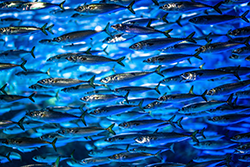Fresh fish in Lincoln, Nebraska. Atlantic Salmon born and raised in America for an American market. Thriving aquatic ecosystems in the Mediterranean Sea, currently the world’s most overfished sea. Realizing these visions are trademark promises made by the land-based aquaculture (LBA) industry. As worldwide fish consumption increases about 1.5% each year and a whopping 75% since 1968 in the United States, LBA has positioned itself as a sustainable alternative to both traditional commercial fishing operations, currently threatening biodiversity, and marine aquaculture, which entails its own ecosystem impacts.
Recirculating aquaculture systems, or RAS, is without a doubt the big fish of LBA. Just like it sounds, RAS means reusing water needed for operations—usually between 90% and 99% reuse—through mechanical and biological treatment. Proponents claim RAS is environmentally superior, thanks to reduced need for antibiotics, separation from local ecosystems (meaning less risk of the sea lice infestations and eutrophication associated with marine operations), and lower greenhouse gas (GHG) emissions by situating RAS facilities close to key markets.

Opponents point out RAS facilities consume substantial energy, discharge water effluent containing metals and other contaminants, are responsible for GHG emissions associated with energy use and feed, and raise questions about proper siting and land use.
Critically evaluating these environmental impacts—and how states and localities can most effectively regulate them—is increasingly important as RAS operations pop up across the United States from Maine to California. This entails analyzing the industry’s sustainability promises, understanding gaps in current regulatory frameworks, and encouraging best practices.
Maine offers a particularly good case study, with three large-scale RAS facilities set to open in the state over the next decade. Let’s dive in:
- The Whole Oceans facility, proposed for Bucksport, Maine, would produce up to 20,000 metric tons of Atlantic Salmon. The company pledges a 95-99% water recirculation rate, but plans for the facility anticipate diverting 18.6 million gallons per day (GPD) from the Penobscot Bay. This equates to 1.28 cubic meters of water for every kilogram of fish produced a year. Compared with the U.N. Food and Agriculture Organization’s (FAO’s) definition of a super intensive RAS operation, which uses only 0.3 cubic meters of water per kilogram and therefore most fully fulfills the industry promise of decreased water consumption, the Whole Oceans facility would be categorized somewhere between intensive and low-level RAS.
What about energy use? The facility would source its power from Central Maine Power Co, which releases carbon dioxide and sulfur dioxide both at higher levels than the New England average.
- The Nordic Aquafarms facility proposed for Belfast, Maine, has faced permitting and judicial challenges. First, the state supreme court paused further steps, ruling intertidal zones needed to construct intake Pipes to Penobscot Bay were owned by neighbors. Then, in June 2023, the Maine Department of Environmental Protection suspended both Site Location of Development Law and Natural Resources Protection Act Permit and its Air Emissions License for the facility, also because of issues related to rights to the intertidal land. Belfast’s elected government nevertheless supports the company and intends “the project will proceed as planned,” pending further judicial review and the result of an ongoing eminent domain case. If the project does come to fruition, Nordic would raise 30,000 metric tons of Atlantic Salmon, using 7.7 million GPD of water, equivalent to 0.35 cubic meters of water annually per kilogram of fish produced. This qualifies the facility’s RAS technology as somewhere between super intensive and intensive, more water efficient than the Whole Oceans facility.
The environmental tradeoff is 196,030 square feet of temporary alterations and 645,283 square feet of permanent alterations to freshwater and coastal wetlands.
- The proposed Kingfish facility in Jonesport, Maine, would produce between 6,000 and 8,000 metric tons of Yellowtail Kingfish, at 0.007 cubic meters of water per kilogram of fish. By far the lowest water usage rate of all three facilities, Kingfish qualifies as a super intensive RAS facility, the most efficient type, according to the FAO. Still, the development would directly impact 7,136 square feet of coastal wetland, 261,196 square feet of freshwater wetland, including 64,004 square feet considered of special significance. On the flip side, the company’s website claims the operation will run on 100% renewable energy.
Clearly, not all RAS is created equal. Water consumption, energy efficiency, and impacts to the land and ecosystem all depend on the individual facility. This means regulators are on the proverbial hook to ensure RAS facilities are truly sustainable.
In Maine, all these proposed facilities must obtain permits from federal, state, and local agencies. These permits do, to a degree, set requirements and conditions on effluent discharge, surface and groundwater impacts, alteration of wetlands, and GHG emissions. Still, ELI’s report on the RAS industry, Fish Forward: Best Practices for Sustainable Land-Based Aquaculture in Maine, clearly demonstrates there is room for improvement.
Among the report’s recommended best practices are requiring environmental impact assessments early in the project proposal stage, allowing facilities to be sited only in areas zoned for industrial use, avoid siting near sensitive habitats, and establishing benchmarking and reporting guidelines for energy consumption. Other suggestions include setting mandatory landfill diversion requirements, increasing public participation in the planning process, adopting a centralized permitting system, issuing licenses for carrying out RAS, and regularly updating standards and guidelines.
Learn much more about how state and local policymakers, in Maine and around the world, are regulating land-based RAS aquaculture and exploring sustainability best practices, by listening to our latest podcast on the topic and by checking out ELI’s Fish Forward report. Policymakers can draw from best practices recognized by international standard-setting bodies and existing land-based finfish RAS facilities to address and mitigate the detrimental environmental and social impacts of land-based finfish RAS aquaculture.

